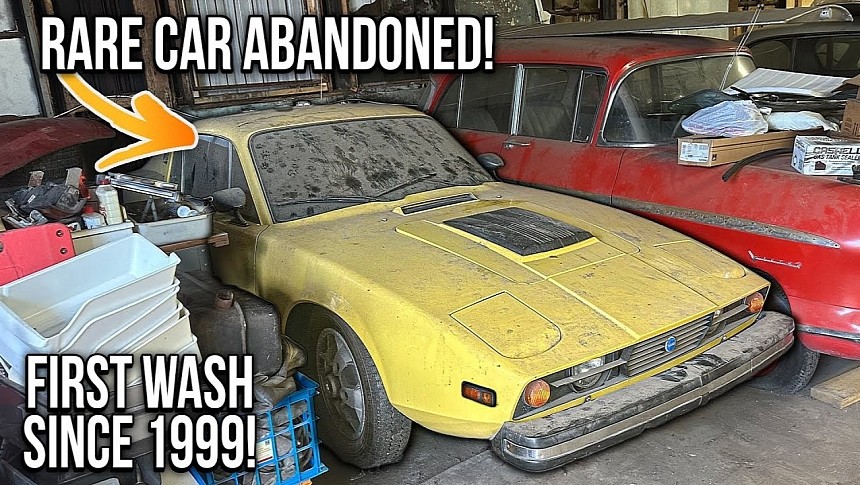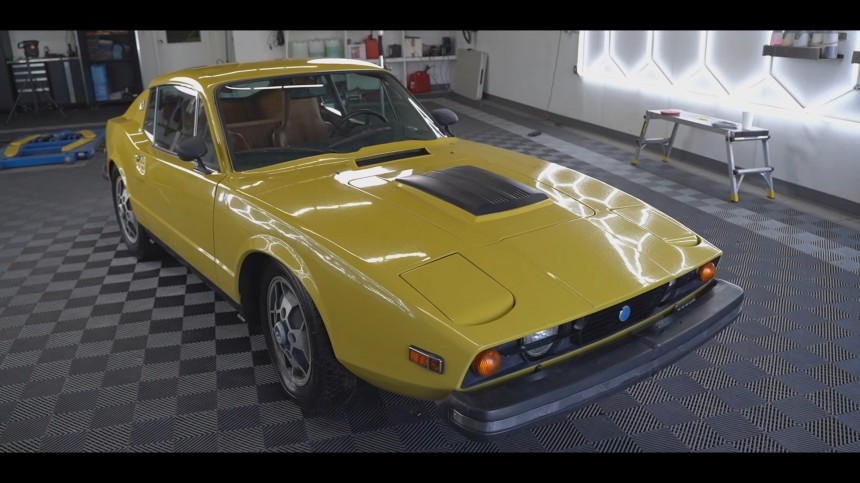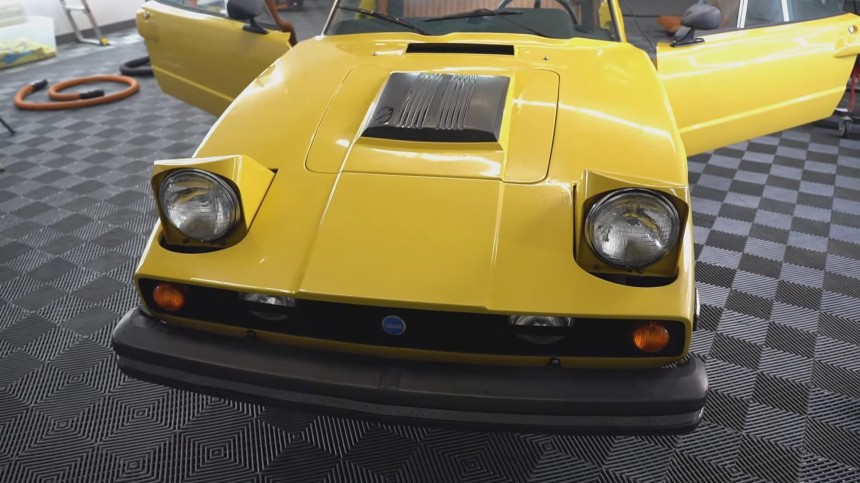Sweden is an automotive paradox – the European nation isn’t famed for the vast spread of automobile brands built by the descendants of Vikings, but the craftsmanship is a world yardstick. Volvo is synonymous with safety; Koenigsegg is a longer word for “fast(est),” that’s about it. But there was one other company that made outstanding cars – so far off the mainstay ideology of carmaking that it never garnered the critical mass to become a worldwide staple of automotive. At one point, the culprit even tried to challenge the Corvette for the sportscar title of America.
SAAB is the now-defunct Scandinavian automaker that put all its airplane-building know-how behind its terrestrial vehicle operations. The Swedes are best known today for their supersonic jets, but there was one time when their cars were equally impressive (and rare). The brave Europeans even tried their hand at making sportscars – and failed.
It was probably a misfortunate combination of practical design, solid engineering, and bullet-proof materials quality that simply axed SAAB’s success as a sportscar manufacturer. After all, what would it be like for rich people to buy outrageously expensive cars that offer comfort, don’t require obscenely overpriced maintenance sessions, and are impeccably reliable?
SAAB aimed precisely at those weak points (true to Swedish pragmatism, they believed cars should work as advertised) and built the Sonett. In proper Scandinavian stubborn fashion, the company made it to the third generation of the model before finally giving up on the idea. The first Sonett was a two-seat roadster and made a touchdown on Planet Piston in the spring of 1956.
The carmaker built it for two years, then took a decade off before introducing the Sonett II in 1966. Due to several mechanical drawbacks, the car wasn’t a sales success, and it was replaced for the 1970 model year by the – you guessed it – Sonett III.
This was the last generation, and it ended in 1974 – strangely, despite being manufactured on the far side of the Atlantic (as seen from Detroit), its fate was sealed by the Clean Air Act (with a significant influence from the Arab Oil boycott of 1973). This oddity was due to the car being sold mainly on the U.S. market.
The third generation was the Sonett’s most popular, with 8,368 assembled between 1970 and 1974, and the low numbers make it one of the all-time rarest SAAB models. It was also the last two-seater automobile of the Swedish make, and it featured some quirks that pointed to its aeronautically inclined engineers and designers.
For starters, the small SAAB was radically against the sportscar paradigm, with a front-wheel drive architecture, a small V4 engine with 1.7 liters of displacement (that’s 103.6 cubic inches, yes), and a trunk big enough to fit a golf bag with the clubs in it. The transmission was a four-on-the-floor with freewheel, putting all 65 hp and 85 lb-ft down. That’s 66 PS and 115 Nm for a 1,900-lb. (862 kg) two-seater.
Those specs refer to the last two years of production when the Sonett III came with the big engine. Between 1970 and 1972, the car had a 1.5-liter V4 with identical output to the later model from ’73-‘74. Fighting emissions-compliant constraints wasn’t easy, even for the ingenious Swedes, and the model was discontinued at the end of 1974.
The interior was as deviant from classic norms as the outside: a big tachometer took the center of the instruments cluster, with the speed gauge to the right and engine status indicators to its right. The three-point seatbelts had no buckles; instead, the strap was locked in place by a latch. The high-back bucket seats are nothing short of racing material – single-piece fiberglass shell with thin foam padding and leather upholstery. There were no back support adjustments, obviously, but they did have lumbar support cushions.
To keep weight down, the entire body was made of fiberglass-reinforced plastic, alleviating weather and elements resistance. A properly cared-for SAAB Sonett III will look as good now as it did when it rolled off the assembly line. Look at the first video and see one example sitting for nearly a quarter of a century – a good detailing job and the 37k-mile car (59,000 km or so) shines bright again.
Several details make the Sonett stand out from the crowd of 1970s sportscars, with the powertrain being the most striking. Built by Ford of Europe, the V4 engine is longitudinally entirely mounted in front of the wheels – hence the disproportionately long front section. Another oddity was the absence of a traditional hood. A tiny engine bay lid provided basic access to the motor. Still, major repairs required the entire front clip to be dismantled.
At the opposite end, the trunk lid was one big piece of glass with its hinges bolted on top of the body on the outside. This simple and effective engineering mentality was reflected in how the front popup lights were devised: instead of using complicated, heavy, or expensive mechanisms for opening and closing the housings, a simple pull lever under the dash did the job. Granted, it hindered leg room for the driver since it protruded about a foot under the steering wheel.
The Achille’s heel of the SAAB Sonett III was its frame – the all-welded steel chassis was not immune to rust and corrosion, but the example the guys from WD Detailing found and cleaned up looks pretty solid. All in all, the rare car would make for an excellent addition to a collector’s trove, but good luck finding parts. Unless new old stock is available, components are nearly impossible to procure, as there are no third-party manufacturers.
And I’m not talking about engine or body pieces, but consumables like brake pads for the front disc brakes, for example. SAAB uniquely devised them with different thicknesses at the ends, so no regular pads are compatible. And don’t slam the trunk lid too hard; otherwise, you’ll end up with a permanent gaping rear ventilation opening.
Mechanical originality aside, the SAAB Sonett III was akin to its company’s safety creed, with a cowl bulkhead at the front of the passenger compartment and another sheet-metal box bulkhead immediately behind the seats. The fuel tank is enclosed in this second bulkhead, which also serves as the anchor point for the tubular overhead roll bar.
The reinforced windshield pillars were another strong point (pun intentional) of SAAB safety-minded engineering. Play the second video for a more in-depth review of a lat-generation SAAB Sonett III (coincidentally, it's the same Mellow Yellow shade as the one found by the WD Detailing gang).
Despite being slightly more powerful than a contemporary lawnmower, the last SAAB sportscar was good for 105 officially claimed mph (169 kph). However, the acceleration wasn’t exactly sporty (what would you expect from an engine that produced about as much torque as a meatgrinder?), with 11.5 seconds for the zero-to-sixty trial. This is probably one reason the car wasn’t particularly attractive to buyers, and the Swedish makers pulled the curtain on the model after disappointing sales during its five-year production run.
It was probably a misfortunate combination of practical design, solid engineering, and bullet-proof materials quality that simply axed SAAB’s success as a sportscar manufacturer. After all, what would it be like for rich people to buy outrageously expensive cars that offer comfort, don’t require obscenely overpriced maintenance sessions, and are impeccably reliable?
SAAB aimed precisely at those weak points (true to Swedish pragmatism, they believed cars should work as advertised) and built the Sonett. In proper Scandinavian stubborn fashion, the company made it to the third generation of the model before finally giving up on the idea. The first Sonett was a two-seat roadster and made a touchdown on Planet Piston in the spring of 1956.
This was the last generation, and it ended in 1974 – strangely, despite being manufactured on the far side of the Atlantic (as seen from Detroit), its fate was sealed by the Clean Air Act (with a significant influence from the Arab Oil boycott of 1973). This oddity was due to the car being sold mainly on the U.S. market.
The third generation was the Sonett’s most popular, with 8,368 assembled between 1970 and 1974, and the low numbers make it one of the all-time rarest SAAB models. It was also the last two-seater automobile of the Swedish make, and it featured some quirks that pointed to its aeronautically inclined engineers and designers.
Those specs refer to the last two years of production when the Sonett III came with the big engine. Between 1970 and 1972, the car had a 1.5-liter V4 with identical output to the later model from ’73-‘74. Fighting emissions-compliant constraints wasn’t easy, even for the ingenious Swedes, and the model was discontinued at the end of 1974.
The interior was as deviant from classic norms as the outside: a big tachometer took the center of the instruments cluster, with the speed gauge to the right and engine status indicators to its right. The three-point seatbelts had no buckles; instead, the strap was locked in place by a latch. The high-back bucket seats are nothing short of racing material – single-piece fiberglass shell with thin foam padding and leather upholstery. There were no back support adjustments, obviously, but they did have lumbar support cushions.
Several details make the Sonett stand out from the crowd of 1970s sportscars, with the powertrain being the most striking. Built by Ford of Europe, the V4 engine is longitudinally entirely mounted in front of the wheels – hence the disproportionately long front section. Another oddity was the absence of a traditional hood. A tiny engine bay lid provided basic access to the motor. Still, major repairs required the entire front clip to be dismantled.
At the opposite end, the trunk lid was one big piece of glass with its hinges bolted on top of the body on the outside. This simple and effective engineering mentality was reflected in how the front popup lights were devised: instead of using complicated, heavy, or expensive mechanisms for opening and closing the housings, a simple pull lever under the dash did the job. Granted, it hindered leg room for the driver since it protruded about a foot under the steering wheel.
And I’m not talking about engine or body pieces, but consumables like brake pads for the front disc brakes, for example. SAAB uniquely devised them with different thicknesses at the ends, so no regular pads are compatible. And don’t slam the trunk lid too hard; otherwise, you’ll end up with a permanent gaping rear ventilation opening.
Mechanical originality aside, the SAAB Sonett III was akin to its company’s safety creed, with a cowl bulkhead at the front of the passenger compartment and another sheet-metal box bulkhead immediately behind the seats. The fuel tank is enclosed in this second bulkhead, which also serves as the anchor point for the tubular overhead roll bar.
Despite being slightly more powerful than a contemporary lawnmower, the last SAAB sportscar was good for 105 officially claimed mph (169 kph). However, the acceleration wasn’t exactly sporty (what would you expect from an engine that produced about as much torque as a meatgrinder?), with 11.5 seconds for the zero-to-sixty trial. This is probably one reason the car wasn’t particularly attractive to buyers, and the Swedish makers pulled the curtain on the model after disappointing sales during its five-year production run.














































































